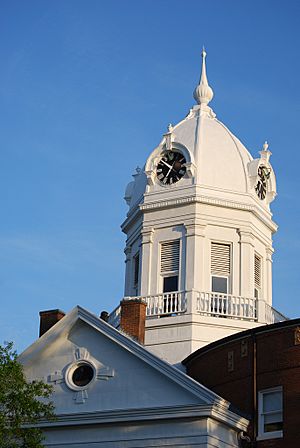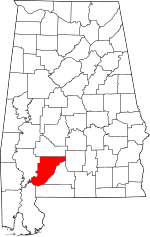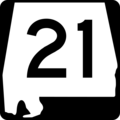Monroe County, Alabama facts for kids
Quick facts for kids
Monroe County
|
|
|---|---|

The Old Monroe County Courthouse in Monroeville
|
|

Location within the U.S. state of Alabama
|
|
 Alabama's location within the U.S. |
|
| Country | |
| State | |
| Founded | June 29, 1815 |
| Named for | James Monroe |
| Seat | Monroeville |
| Largest city | Monroeville |
| Area | |
| • Total | 1,034 sq mi (2,680 km2) |
| • Land | 1,026 sq mi (2,660 km2) |
| • Water | 8.7 sq mi (23 km2) 0.8% |
| Population
(2020)
|
|
| • Total | 19,772 |
| • Estimate
(2023)
|
19,229 |
| • Density | 19.122/sq mi (7.383/km2) |
| Time zone | UTC−6 (Central) |
| • Summer (DST) | UTC−5 (CDT) |
| Congressional district | 1st |
|
|
Monroe County is a county located in the southwestern part of Alabama, a state in the United States. In 2020, about 19,772 people lived here. The main town and county seat is Monroeville. The county is named after James Monroe, who was the fifth President of the United States.
Monroe County is known as the "Literary Capital of Alabama." This is because famous writers like Harper Lee and Truman Capote grew up here. Harper Lee wrote the very popular book To Kill a Mockingbird. This book, and the movie made from it, bring many visitors to the area. Monroeville is also featured in the 2019 movie Just Mercy, which is based on a true story about a lawyer helping someone who was wrongly accused.
Contents
History of Monroe County
For thousands of years, different groups of indigenous peoples lived in this area. Later, the Creek people were the main group here. They were known as one of the "Five Civilized Tribes" in the Southeast.
A famous Creek leader named Red Eagle (also called William Weatherford) settled here after the Creek War (1813-1814). He started a successful farm. Most of the Creek people were later moved from Alabama to what is now Oklahoma in the 1830s.
European Americans, mostly from England and Scotland-Ireland, then settled the area. They built large farms, often growing cotton. Many people were forced to work on these farms as slaves. Sometimes, the number of enslaved people was even higher than the number of white settlers.
After the American Civil War, slavery ended. However, new laws were made that treated African Americans unfairly. These laws made it hard for them to vote and kept people separated based on their race. This time was known as the Jim Crow era.
Monroe County is the home of two important 20th-century authors, Truman Capote and Harper Lee. They were childhood friends. Other writers from Monroe County include Mark Childress and journalist Cynthia Tucker. In 1997, Alabama officially named Monroeville and Monroe County the "Literary Capital of Alabama."
The county is close to the Gulf Coast, so it can be affected by big storms called hurricanes. It was declared a disaster area in 1979 after Hurricane Frederic and again in 2004 after Hurricane Ivan.
A lawyer named Bryan Stevenson wrote a book called Just Mercy in 2014. He works to help people who are wrongly accused, especially those on death row. He helped Walter McMillian, an African American man from Monroe County, who was wrongly convicted of murder in 1989. After six years, the court ruled that McMillian should be set free because there was no real proof against him.
Geography
Monroe County covers about 1,034 square miles. Most of this area is land, with a small part being water.
Main Roads
 U.S. Highway 84
U.S. Highway 84 State Route 21
State Route 21 State Route 41
State Route 41 State Route 47
State Route 47 State Route 59
State Route 59 State Route 83
State Route 83 State Route 136
State Route 136
Neighboring Counties
- Wilcox County (north)
- Butler County (east-northeast)
- Conecuh County (east)
- Escambia County (southeast)
- Baldwin County (southwest)
- Clarke County (west)
Population Information
| Historical population | |||
|---|---|---|---|
| Census | Pop. | %± | |
| 1820 | 8,838 | — | |
| 1830 | 8,782 | −0.6% | |
| 1840 | 10,680 | 21.6% | |
| 1850 | 12,013 | 12.5% | |
| 1860 | 15,667 | 30.4% | |
| 1870 | 14,214 | −9.3% | |
| 1880 | 17,091 | 20.2% | |
| 1890 | 18,990 | 11.1% | |
| 1900 | 23,666 | 24.6% | |
| 1910 | 27,155 | 14.7% | |
| 1920 | 28,884 | 6.4% | |
| 1930 | 30,070 | 4.1% | |
| 1940 | 29,465 | −2.0% | |
| 1950 | 25,732 | −12.7% | |
| 1960 | 22,372 | −13.1% | |
| 1970 | 20,883 | −6.7% | |
| 1980 | 22,651 | 8.5% | |
| 1990 | 23,968 | 5.8% | |
| 2000 | 24,324 | 1.5% | |
| 2010 | 23,068 | −5.2% | |
| 2020 | 19,772 | −14.3% | |
| 2023 (est.) | 19,229 | −16.6% | |
| U.S. Decennial Census 1790–1960 1900–1990 1990–2000 2010–2020 |
|||
Population in 2020
In 2020, there were 19,772 people living in Monroe County.
| Race | Number | Percent |
|---|---|---|
| White | 10,334 | 52.27% |
| Black or African American | 8,253 | 41.74% |
| Native American | 281 | 1.42% |
| Asian | 88 | 0.45% |
| Other/Mixed | 609 | 3.08% |
| Hispanic or Latino | 207 | 1.05% |
Population in 2010
In 2010, the population was made up of:
- 55.1% White
- 41.7% Black
- 1.1% Native American
- 0.3% Asian
- 1.4% Two or more ethnicities
- 1.0% Hispanic or Latino (of any ethnicity)
Communities
City
- Monroeville (This is the county seat)
Towns
Census-Designated Places
These are areas that are like towns but are not officially incorporated.
Unincorporated Communities
These are smaller communities without their own local government.
Ghost Towns
These are towns that used to exist but are now abandoned.
Education
Monroe County has one main school district, called the Monroe County School District.
Places to Visit
Monroe County has several interesting places to visit. These include the Alabama River Museum, the Monroe County Heritage Museum, and the Courthouse Museum. The Courthouse Museum is famous for hosting the yearly play of To Kill a Mockingbird. You can also visit Claude Kelly State Park.
Images for kids
See also
 In Spanish: Condado de Monroe (Alabama) para niños
In Spanish: Condado de Monroe (Alabama) para niños








